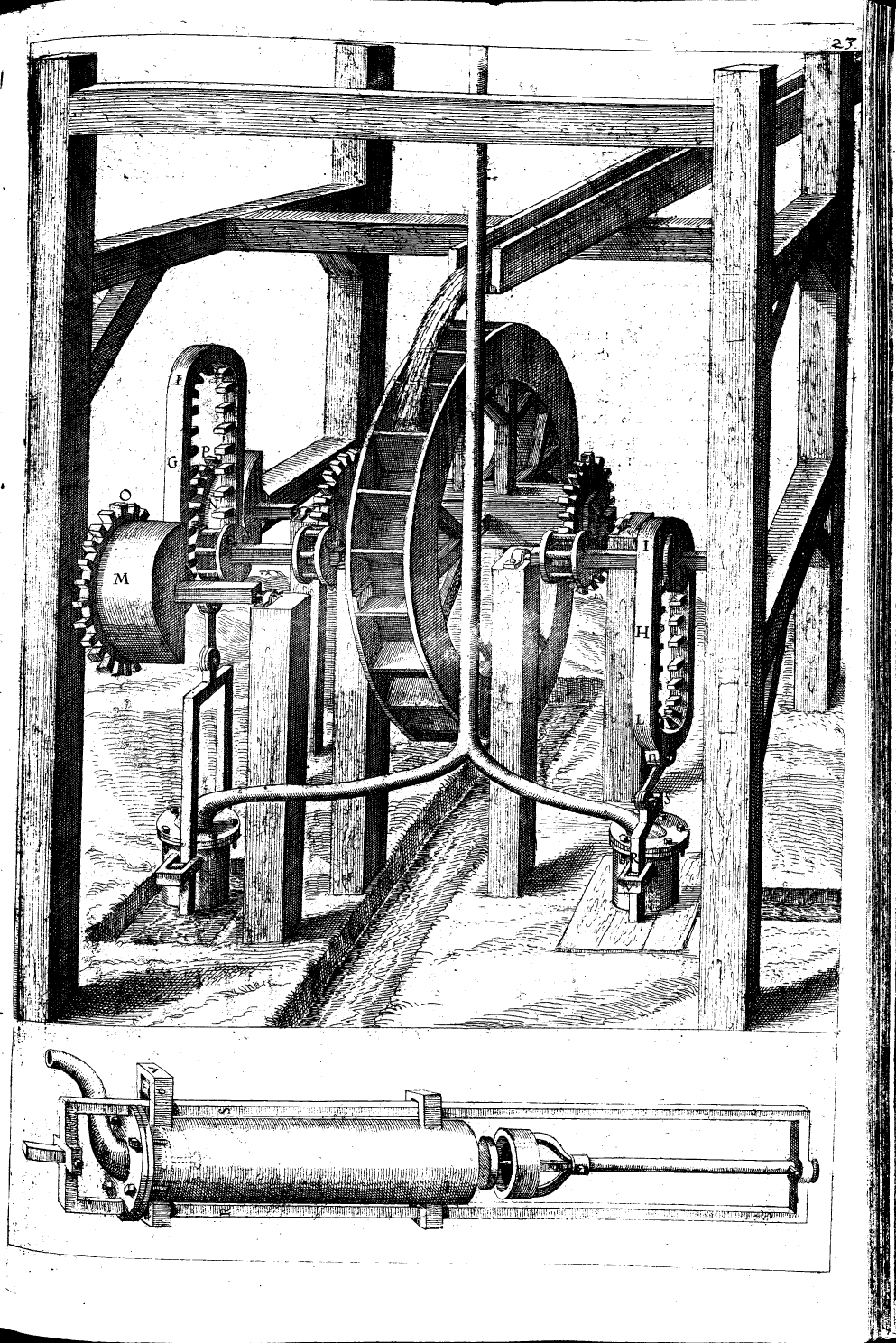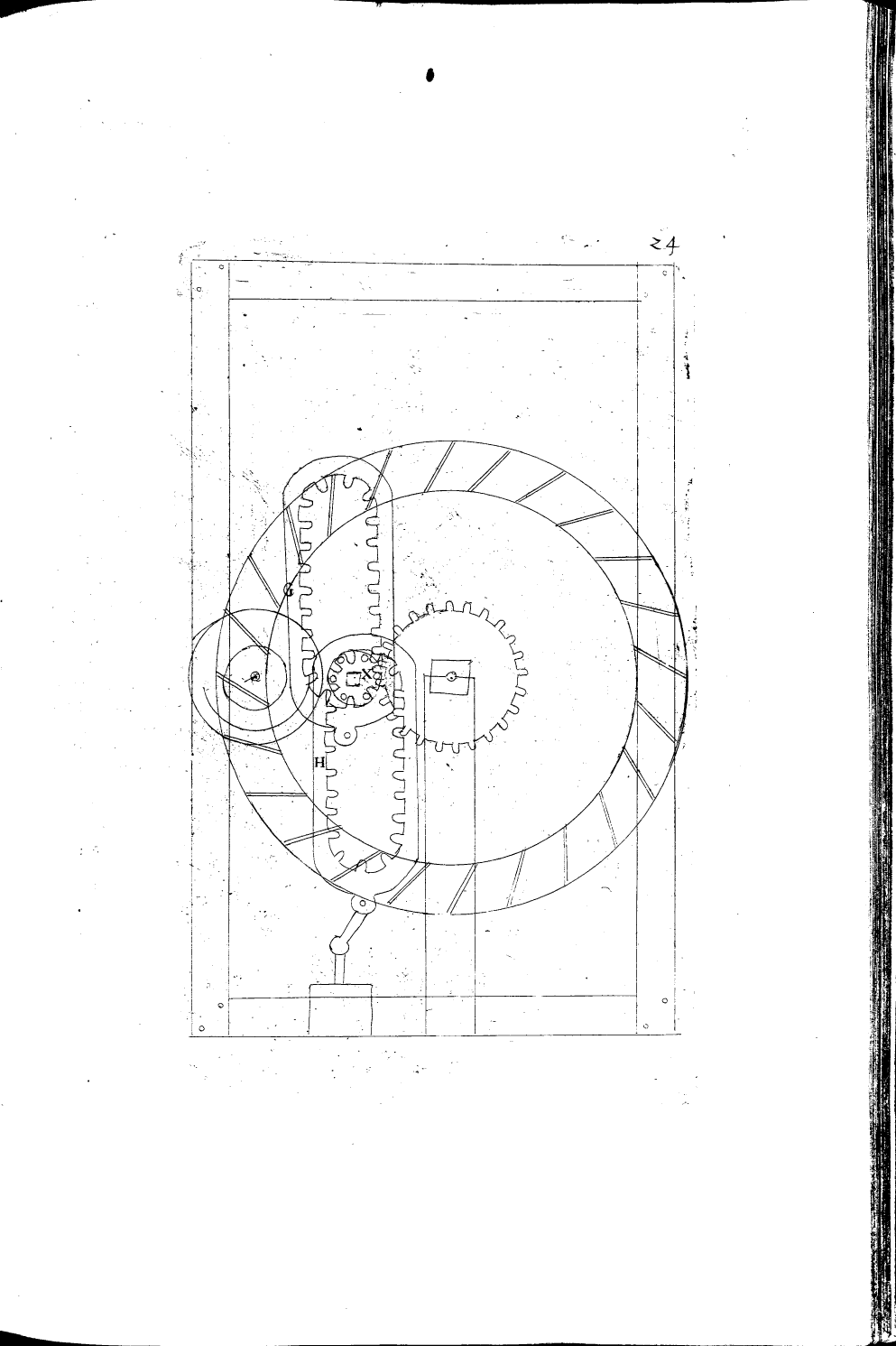Hagiography: the de Caus Clan
The de Caus clan is just one of the enigmas surrounding the history of the Theatri Machinarum. Salomon was either the elder brother, uncle, or father of Isaac. Salomon is remembered for a wide variety of reasons including his contributions to musical theory and garden design. What most interests me, however, is his contribution to the books of machines: Les Raisons des forces mouvantes (Frankfurt am Main, 1615/R Amsterdam, 1973).
The four volume opus was later revisited by Isaac. He created an edited version entitled Nouvelle invention de lever l’eau plus hault que sa source avec quelques machines mouvantes par le moyen de l’eau et un discours de la conduite d’icele (London, 1644). An English edition was subsequently printed in 1659 by Joseph Moxon, friend of Robert Hooke and printer of the Royal Society. The English edition carries the somewhat onerous title: New and rare inventions of water-works shewing the easiest waies to raise water higher then the spring : by which invention the perpetual motion is proposed : many hard labours performed : and varieties of notions and sounds produced : a work both usefull profitable and delightfull for all sorts of people.
I have written previously about how odd it was that James Watt did not own any of the TM despite having consulted Leupold in his youth. It seems that James—or perhaps his son, James—did own a French copy of Isaac de Caus’s work. This work was recently listed by Hugh Pagan Ltd. and contains blank pages filled with scientific notes written in a Dutch and seventeenth-century hand. An added plate executed by the Amsterdam engraver Abraham Rausden shows an experimental paddle-driven ship. The work carried a list price of £6,850 (Hugh Pagan Ltd., Catalogue 53 : Architectural and International Exhibitions).
The relationship between Salomon and Isaac is somewhat ambiguous. Consistent with earlier entries, I will attempt to piece their lives together in a sort of hagiography.
Salomon de Caus | Isaac de Caus |
1576. Salomon is born as a Huguenot from the Dieppe/Normandy region of France. 1595-1598. He visits Italy where he views the gardens and mechanical devices of Bernardo Buontalenti at Pratolino near Florence. 1598-1610. Salomon lives and works in Brussels in the employee of the Standholder of the Netherlands, Albert, Archduke of Austria. He designs wells, fountains, and automata. 1610-1613. He lives in England in the service of Price Henry to whom he taught drawing. With Contantino de’ Servi he supervised the waterworks at Richmond Palace. De Caus dedicates his first book—De Perspective—to Henry and Les Raisons includes some designs from Henry’s gardens. 1612. He publishes La Perspective, avec la raison des ombres et miroirs (London, 1612). 1 April 1613. De Caus enters the service of Elector Frederick V of the Palatinate as architect and engineer. His most important work—the Hortus Palatinus—is constructed during this period. The work remained uncompleted when Frederick fled to Prague. 1615. He publishes Les Raisons des forces mouvantes (Frankfurt am Main, 1615/R Amsterdam, 1973). 1620. He enters the service of King Louis XIII of France. He is in charge of cleaning the streets and squares of Paris and for installing fountains. He publishes Hortus Palatinus (Frankfurt am Main, 1620/R Paris, 1981). 1624. Salomon publishes La Pratique et démonstration des horloges solaires, avec un discours sur les proportions (Paris, 1624) 28 February 1626. Salomon dies. | 1623-1624. Isaac is involved in the construction of a grotto in the basement of the Banqueting House in London, designed by Inigo Jones. Pre 1625. De Caus may have been the chief garden designer of King James I. 1625-1649. His role as designer may have continued through the rule of Charles I. 1630-1633. Isaac builds a grotto at Somerset House for the French wife of Charles I, Henrietta Maria. 1633-1634. He acts as the executant architect for Francis Russell, 4th Earl of Bedford. He built the houses on the Bedford estate at Covent Garden, and the garden adjacent to the south piazza. He may also have executed the grotto, and the west and south fronts of Woburn Abbey, Bedford’s family seat. 1634. Isaac is naturalized as British citizen. He gains professional success with a commission from Philip Herbert, 4th Earl of Pembroke to rebuild Wilton House. Inigo Jones was also involved in this project. His redesign of the gardens throughout the 1630s and 1640s introduced the latest French fashions of design to England. 1638. He may have designed Stalbridge Park, Dorset, for Richard Boyle, 1st Earl of Cork and father of Robert Boyle (1627-1692). 1644. He publishes Nouvelle invention de lever l’eau plus hault que sa source avec quelques machines mouvantes par le moyen de l’eau et un discours de la conduite d’icele (London, 1644). He is also given a pension and accommodation for life by the Herbert family. After 1655. Isaac dies sometime after 1655. 1659. Moxon publishes New and rare inventions. It refers to the “late Isaak de Caus” |
Salomon may have also had a different role. Rosalie Colie, for example, discusses his influence on Bacon’s New Atlantis. She notes that Bacon would have had few examples for his academy since only Brahe and Rudolph II had managed to assemble anything that even remotely resembled our modern notion of a scientific academy. Instead, Bacon had to look to other influences from Prince Henry’s court, notably Salomon de Caus and Cornelis Drebbel.
The mechanical engines noted by Bacon may have been influenced by the work of de Caus:“However unimportant Caus’s elaborate renaissance fountains might appear to the casual student, they were no mere toys for princes and great ones; the complex motions of his moving figures and of his musical fountains resulted from genuinely imaginative experimentation in mechanics.” (pg. 250)
She continues:“From such contemporaries as Drebbel and Caus, like him conducting their business in the sovereign’s service, he could perceive the remarkable results of dedicated occupation with particulars; from them the practical method of his academy took form. The great parable of Salomon’s House the two inventors, the two projectors contributed; their creative imaginations moved Bacon to his visions of an unequalled utopian world, a utopian ideal to be put into practice, a purpose for the perpetual motion of the advancement of learning.” (pg. 260)
Bachrach (1980) compares Salomon to Leonardo: "The Renaissance engineer was, like him, both artist and artisan, both military expert and organizer of Courtly entertainment--a professional, in other words, whose mind was primarily turned towards obtaining thought-provoking effects from the not invariably 'holy' alliance of science and Humanism. Drebbel and De Caus were such characters, even if De Caus was the greater talent and the more creative personality." (pg. 47)
The elder de Caus may also have had an influence on Christian Huygens... or at least his father. Constantine Huygens was working as an ambassador in England where he ran in the very particular circle of Sir Robert Killgrew. Killigrew's wife was the former Mary Woodhouse, niece of Sir Francis Bacon. This circle also included the widow of Sir Walter Raleigh (Bess Throckmorton, who managed the Irish estates at Youghal that Raleigh sold to Robert Boyle's father), Ben Jonson, John Donne, Inigo Jones, the Huguenots Lanier and Drebbel, Isaac de Caus and Cornelius Drebbel, and--of course--Sir Francis Bacon.
Isaac was also a member of the Killigrew circle. Interestingly, Isaac's greatest accomplishements were at Wilton which was visited by Christian's younger brother Lodewijck in 1652.
Killigrew's circle overlapped with Prince Henry's entourage. Following Henry's death in 1612, Drebbel became attached to the Court of James I while de Caus fell into the entourage of Princess Elizabeth, soon to become the the Queen of Bohemia. After the fall of the Winter Monarchs, de Caus returned to France rather than follow his patrons into exile.
The era of beauty and experiment that marked the (very brief) reign of Frederick V, Elector of the Palatinate, and Elisabeth is recounted in Fraces Yates's The Rosicrucian Enlightenment. Isaac and Salomon figure in to Yates's thesis due to their strong commitment to enlightenment diversions such as mechanics, musical theory, automata, and garden design. As noted by Bachrach:
"By the same token the magical world of the late Renaissance, with its preoccupation with occult forces and influenes, can be observed almost imperceptibly to give way to the age of experiment. And so, in the new architecture and garden-design, too, we are increasingly confronted with the spirit out of which the Royal Society was to emerge--a spirit and a society for which experiment was at its most spectacular in the mechanistic and optical fields." (1980, pg. 47)
The de Caus clan appears in one more bizarre footnote (literaly) in history. The origin is that source of so many other interesting quirks of English science: the mint. On the 19th of February 1660, Samuel Pepys walked in the Gallery at Whitehall where he met with Henry Slingsby, a friend of Evelyn's and then-Deputy-Master of the Mint. Slingsby showed Pepys stamps for new coinage, to be struck by "Mons. Blondeau" who "will shortly come over."
It seems that Pierre Blondeau had originally left Paris for the London Mint in 1649 but was soon driven out. He returned after the Restoration to introduce coinage with milled edges to the realm. On 13 April 1662, Blondeau's machinery was first put into use. Challis continues the story: "For £1,000 Blondeau was to supply all the machinery used by the moneyers as well as the edging machine which was to be under his control. Maintenance of the machinery was Blondeau's responsibility and when his patent expired everything was to be left in good working order. In addition to instructing the moneyers he was to engrave the steel strips for edge marking the blanks, ensure that all blanks were round before being sized, and edge the blanks with letters or grainings before they were to be stamped." (pg. 343) [I detect shades of Nartov in this discussion]
Blondeau was probably grateful to Slingsby for his return to England. He bequeathed Slingsby one-third of the income from the unexpired term of his patent (and five Polish presses for coining farthings [If the Poles had decent presses, why were the Russians so far behind in Nartov's time?]). The remaining two thirds has a very interesting history and it involves de Caus:
"The remaining two-thirds of the patent Blondeau left to Isaac de Caux and John Colbourne. Between them, the beneficiaries were to pay Peter la Castille £20 per annum 'in consideration of his labour' in the edge-marking process. When Colborne died, in 1679, he bequethed the two-thirds share equally to his brother, Robert, and Slingsby, provided that Slingsby provided someone to carry on the business of the patent. If Slingsby failed to do this, the patent was to go equally to Robert Colborne and Peter Johnson." (pg. 343, n. 284)
It's unclear what kind of relationship Isaac de Caus had with Blondeau.
Pepys's explanation of the new mint processes of Blondeau (and perhaps Isaac de Caus) make for good reading.
UPDATE
I came across another reference to de Caus. Châtelet-Lange describes a brief manuscript written in the hand of Salomon de Caus. It contains a commentary on the first book of Vitruvius. It occurs in the form of a conversation between an engineer--who defends architecture--and a mathematician. She provides the following reference: Valenciennes, Bibliotheque municipale, ms. 329.
Grove Art Online entries for Salomon de Caus, and Isaac de Caus. Date accessed: January 23, 2006.
Bachrach, A.G.H. (1980). "The role of the Huygens family in seventeenth-century Dutch culture." In Bos, Rudwick, Snelders, and Visser (Eds.) Studies on Christiaan Huygens. Swets and Zeitlinger, Lisse.
Challis, C.E. (1992). A New History of the Royal Mint. Cambridge University Press, New York.
Châtelet-Lange, Liliane (1988). "L'architecte entre science et practique: le cas de Jacques Gentillâtre." In Andre Chastel and Jean Guillaume (eds.) Les traites d'architecture de la Renaissance, pgs 397-406. Picard: Paris.

















